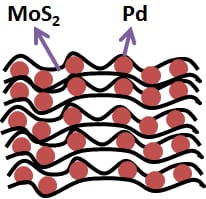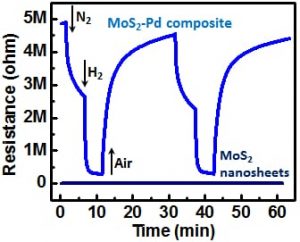 Researchers at the University of California – San Diego report the use of molybdenum disulfide–palladium composites for highly sensitive detection of hydrogen at room temperature. Particular applications of this technology are in detection of H2 leaks from fuel cells, from which there can be serious safety concerns. Metal oxide sensors are often used, but they have a high operating temperature. Sensors that operate at room-temperature would be highly beneficial.
Researchers at the University of California – San Diego report the use of molybdenum disulfide–palladium composites for highly sensitive detection of hydrogen at room temperature. Particular applications of this technology are in detection of H2 leaks from fuel cells, from which there can be serious safety concerns. Metal oxide sensors are often used, but they have a high operating temperature. Sensors that operate at room-temperature would be highly beneficial.
In the work by Professor Sungho Jin and co-workers, a solution-processed MoS2 nanosheet–palladium nanoparticle composite is presented – this composite shows a remarkable electrical response toward hydrogen with excellent response and recovery time.
The composite is prepared by drop-casting of MoS2–PdCl2 solution in SiO2-coated silicon substrates, followed by annealing to reduce the PdCl2. This method produces highly exfoliated MoS2 nanosheets.
The role of palladium in the composite is critical as MoS2 nanosheets alone do not show any significant response to H2 exposure, whereas the composite shows a strong response to 50000 ppm H2. The response to H2 is characterized by a sharp decrease of resistance followed by saturation, and there is complete recovery in air without any heating or UV irradiation. Device response and recovery times were 40 and 83 s respectively. Furthermore, cross-sensitivity to ammonia, acetone, and ethanol is also shown to be minimal, and the device outperforms other candidate devices made from graphene–palladium composite films.
The mechanism for H2 sensing is proposed.
All in all, these results demonstrate the great potential of these systems in the inexpensive and scalable fabrication of high-sensitivity chemical sensors.
Advanced Science is a new journal from the team behind Advanced Materials, Advanced Functional Materials, and Small. The journal is fully Open Access and is free to read now at www.advancedscience.com.


















